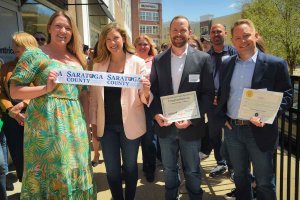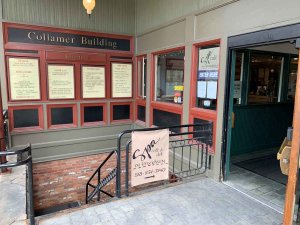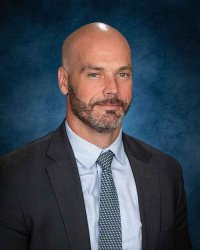Notes from City Hall
Uber in Saratoga Springs Future?
A proposed resolution of the City Council in support of legislation to permit ridesharing companies such as Uber and Lyft to operate locally has been tabled, after it became evident the resolution would not, at this time, have unanimous council support. Commissioners Chris Mathiesen and Michele Madigan expressed concerns about the quality of service that would be provided, and what the long-term effects might be for cab companies currently operating in the city. “I’ve heard a lot of rah-rah stuff about how this will be great for upstate, but I haven’t heard any specifics,” Mathiesen said. Regardless of whether the City Council eventually adopts a resolution, the ultimate decision about whether rideshare companies would be allowed to operate upstate will be made by the state legislature.
This Land Is Your Land, This Land Is My Land
The City Council Tuesday night unanimously approved authorizing the mayor to take steps in executing a property acquisition for the Geyser Road bicyclepedestrian trail. Up to $80,000 has been appropriated for the purposes of the city to acquire a portion of a handful of different parcels through the power of eminent domain. The two-mile trail runs from the town of Milton/ Saratoga Springs city line, to Route 50. An initial feasibility study regarding the trail was conducted in 2009, and the first public meeting in 2013. Construction is slated to begin this spring, and conclude by the end of the calendar year. One area resident and an attorney representing the Saratoga Spring Water company – both of whom would be affected by the acquisition – respectively raised questions with the council about maintenance and upkeep of the trail, and potential safety issues regarding the development of the trail and delivery truck traffic. By law, the city is required to provide just compensation to the owner(s) of the private property to be taken. Written statements from the public regarding the acquisition will be accepted by Jan. 31, by emailing: Bradley Birge, city administrator of planning & economic development at: bbirge@saratoga-springs-org. Documentation will be returned to the City Council within 90 days for a final decision.
Appointment to Board
Mayor Yepsen appointed Amy Smith, owner of the Saratoga Arms hotel, to the Downtown Special Assessment District Board. Smith’s appointment is through July 2018 and will complete the term of Colleen Holmes, who resigned due to family health reasons. Board members typically serve four-year terms. Additional members of the Downtown Special Assessment District Board include: chairman Harvey Fox, Mariann Barker, Mike Ingersoll, Dean Kolligian, Toby Milde, Ray Morris, Tom Roohan and Rod Sutton.
Upcoming
A new date and time has been set for the mayor’s State of the City Address. The event will take place at 6 p.m. on Monday, Jan. 30 at the Saratoga Springs City Center. The Zoning Board of Appeals will host a meeting at 7 p.m. Monday, Jan. 23 at City Hall. The Charter Review Commission will host meetings at 7 p.m. on Tuesday, Jan. 24 and Thursday, Jan. 26 at City Hall. The Planning Board will host a meeting at 7 p.m. Thursday, Jan. 26 at City Hall.
Saratoga Springs Residents to Vote May 30 on City Form of Governing
SARATOGA SPRINGS — If all goes according to plan, city residents will vote in a special election on May 30 that may alter the way Saratoga Springs has been governed since its incorporation as a city in 1915.
Plans call for a ballot providing voters with two options: keep the current City Charter and the commission form of governing as is, or revise the charter with a new form of governing. That proposed new form - the council-manager form of government, was approved by a 14-0 vote by the Commission late Thursday.
The Commission has staged meetings and conducted interviews and surveys during the past seven months. Among its recommendations are increasing the number of council members from five to seven, their terms from two years to four years, and putting a system in place to ensure members come from all corners of the city.
“There’s no magic number, but we felt seven was the right number and it’s also the average number of members in councils across the country,” Charter Review Commission chairman Bob Turner told the City Council on Tuesday. Additionally, the proposed four-year terms – similar to approximately 70 percent of city governments in America - would reduce the frequency of fundraising and campaigning, Turner said.
The commission’s lengthiest discussion concerned the merits of neighborhood districts versus at-large elections. Under the current system, commissioners are elected in city-wide elections. Under a neighborhood district system, council members are elected from a neighborhood or smaller geographic area. Candidates would have to live in the district they represent. Neighborhood districts would make a positive contribution to the electoral and governance process of the city, according to the commission. Neighborhood districts would also make it easier for new candidates to run for office since they would only have to reach out to approximately 4,500 voters instead of 18,000. Commission studies indicate that the vast majority of City Council candidates during the past 15 years have come from a small cluster on the central east side of the city, and argue that neighborhood districts would ensure more geographic representation in City Council affairs.
The Commission also supported giving the City Council confirmation power over all mayoral appointments to city boards and judicial appointments pending state law.
The May 30 date is the last Tuesday that a special election can be held while also allowing new candidates to choose to run for the City Council in 2017, based on whether the charter referendum succeeds or fails.
“A special election in May also gives any candidates for public office the full picture of what the voters want for their form of government, one way or the other,” said commission member Gordon Boyd, in a statement.
What is the Council-Manager Form of Government?
Under the council-manager form of government, the city council approves the budget, determines the tax rate and focuses on the community’s goals, major projects, and such long-term considerations as community growth, land use development, capital improvement plans, capital financing, and strategic planning. The council hires a highly trained non-partisan, professional city manager to carry out these policies with an emphasis on effective, efficient, and equitable service delivery. Managers serve at the pleasure of the governing body and can be fired by a majority of the council.
The council-manager form is the most popular structure of local government in the United States. Among cities with a 25,000-49,999 population, 63 percent of cities have a council manager structure, 31 percent have mayor council, and 1% has the commission form of government. Currently, Saratoga Springs and Mechanicville are the only cities in New York that have the commission form of government, according to the Commission.
Pat Kane, vice-chairman of the 15-member citizen board, said he anticipates total costs to be about $46,000 - $20,000 for legal drafting costs, $20,000 for community information outreach, and about $6,000 in clerical support expense. Additionally, a special election would cost $37,000. There has been push-back among some current council members regarding the timing and the expense of a special election. Specifically, Commissioner John Franck contends that residents will be less likely to make the effort to vote in a special election than they would be in a more traditionally timed vote in November. Commissioner Chris Mathiesen countered that in November all five current council seats will be up for re-election and that adding a charter review vote would only serve to complicate matters and not allow the issue the appropriate focus it deserves.
The council has until late February to approve the request to fund the Commission’s expenses as well as the special election; if it fails to do so, it is believed the mayor has the ability to approve the amount of funding sought. Representatives of the Charter Commission met with members of the city finance department Wednesday, and it is anticipated the council will discuss the funding requests in the near future. The council’s next regularly scheduled meeting is Feb. 7, although a “special” council meeting to specifically discuss the matter may be called for prior to that date.
Saratoga County Sheriff Pushes Back on Safe Act Provision
SARATOGA — A letter from the NYS Police Pistol Permit Bureau mailed to gun owners and reminding them of requirements to recertify their licenses every five years has triggered a defiant response from Saratoga County Sheriff Michael Zurlo, who said he will not have his deputies enforce the SAFE Act provision by “harassing already law-abiding citizens.”
The Pistol Permit Bureau’s letter informs gun owners that if a permit was issued prior to Jan. 15, 2013, the deadline to submit recertification is Jan. 31, 2018. “I will not commit resources by taking deputies off the street to enforce this SAFE Act provision when our deputies have important work to do keeping our communities a safe place to live, work and raise families,” Zurlo said, in a statement. “The purpose of the Saratoga County Sheriff’s Office is to serve and protect the residents of this county, not to harass already law-abiding citizens with the SAFE Act’s Pistol Permit recertification provisions.”
A similar sentiment was echoed by fellow Republican County Clerk Hayner. “Recertification is creating another undue burden to law-abiding pistol permit holders who have invested time and resources obtaining their pistol permit license here in Saratoga County,” Hayner said.
“I’m really surprised (Zurlo) would say something like that, because his job is to enforce the law, said Patricia Tuz, Capital Region Coordinator for New Yorkers’ Against Gun Violence, a nonprofit organization with a mission to reduce gun violence through legislative advocacy and education. “But, he is an elected official and sometimes elected officials say things they believe their constituents want to hear, and then later they reconsider,” Tuz said. “So, I hope he reconsiders.”
The NY SAFE Act, signed into law by Gov. Cuomo in January 2013 in the weeks following the shooting in Newtown, Connecticut, amended state law to include an expanded ban on assault weapons and high-capacity magazines, as well as requirements for background checks. Safeguards included requiring those with existing pistol permits to renew or recertify permits every five years. One year later, the Saratoga County Sheriff and County Clerk worked with the county Board of Supervisors to pass a resolution prohibiting New York State from using the Saratoga County Seal for SAFE Act purposes.
A series of statewide polls conducted by Siena College over a two-year period indicates an average of about 60 percent of respondents support the Safe Act, approximately 33 percent are opposed, and the balance have no opinion on the matter. Regionally, the measure garners more support in the New York City area, than in upstate. “Views on the SAFE Act have remained largely unchanged over time. It has the support of more than three quarters of Democrats and New York City voters and a strong majority of independents and downstate suburbanites. Upstaters are closely divided, with a bare majority opposed and Republicans are strongly opposed,” Siena College pollster Steven Greenberg said in 2015.
Gun owners may recertify pistol permits and check their recertification status on the State Police website at: https://firearms.troopers.ny.gov/pprecert/welcome.faces.
The state police have made it very easy to re-certify with an online form,” Tuz said. “It’s like having a driver’s license, where you have to renew it every few years. It’s a privilege to own a gun, just like it’s a privilege to drive a car.”
A spokesman for the State Police said no comment would be made in response to Zurlo’s statement.
City Police, School District Investigate Hate Speech
SARATOGA SPRINGS — The 18-year-old was between classes and walking through the halls of her high school last week when the actions of a fellow student jarred her into consciousness. “A kid from one of my classes, who I don’t even really know did the Nazi salute. I stopped and looked at him and didn’t even know what to say,” said senior class student Channah Goldman.
She continued walking, to the school library, where she sat at a desk, took out her books and looked down at the series of symbols carved into the desk top. “There were swastikas all over the desk,” said the student, who has visited concentration camps overseas and has seen the fingernail scratches on the chamber walls of victims who were killed. “I felt physically ill and moved to another desk. And there was another one.”
Goldman said a librarian was apologetic and immediately set to the task of cleaning the desks. The student’s captured images show carvings embedded so deeply the desks required a sanding-over and new artwork drawn atop them to obfuscate the hate symbols. Both the incidents were brought to the attention of the school, and it appears they are being resolved internally, according to Goldman, but when her 14-year-old brother, who is also a student in the school district, noticed an Instagram account which appears to represent “Saratoga High School Fourth Reich,” and referenced neo-Nazis, the police got involved.
“My brother came across it and showed it to me,” Goldman said. “He showed it to my family and everyone was really concerned. The school started looking into it and taking it seriously.”
“When we first learned of the Instagram Account, we were involved from the get-go,” said city Police Lt. Robert Jillson. “At this point, we haven’t deciphered the creator of the account, but we did go in and interview in excess of 30 students who followed the account.” The city police department has a school resource officer, or SRO, who works at the school full-time. Investigators determined that students who had opted to follow the account did so based on the name recognition of their high school, but had not delved deeper into the account to learn of its neo-Nazi references. “The intention of the people who created the account, that could be concerning, and we’d like to know and the school would like to know the intention behind it,” Lt. Jillson said.
Swastika graffiti has recently been discovered in at least two locations in the city – near the Caroline Street elementary school and on the Spring Run Trail, as well as other places in the region. The anti-Semitic acts are not new, internationally, or regionally. One hundred and forty years ago, Joseph Seligman, an American banker and financial advisor to the administrations of Abraham Lincoln and Ulysses S. Grant, was famously said to have been barred from staying at the fabled Grand Union Hotel in Saratoga Springs because the hotel’s owner, Judge Henry Hilton, insisted that Jews be excluded from the hotel. According to historian Lee Livney, the “Hilton-Seligman Affair” was featured and editorialized in newspapers coast-to-coast at the time, and has come to be known as a focal point of the origins of American anti-Semitism.
A letter penned by Michael Piccirillo, Superintendent of Saratoga Springs Schools, on Wednesday informed members of the school community about the Instagram account.
“I wish to make clear that the views expressed on this site (SHS4R) are not representative of the school district’s beliefs nor are they authorized in any way or representative of any club or activity associated with the school district. The Saratoga Springs City School District denounces any speech which promotes acts of hatred or violence against any individual or group,” Piccirillo said. “The SHS4R page directly refers to a site that espouses white supremacy and anti-Semitic rhetoric. In addition, the moniker SHS4R inappropriately and without any permission directly relates the name of our high school to concepts expressed by Nazi Germany.” The letter concludes: “It is incumbent upon us to take an active role in exposing intolerance and teaching our children to celebrate diversity as a strength. We ask all parents to speak with their own children about such ideals and encourage the same diversity and inclusiveness we promote at school. Together we can strengthen our culture and build a strong foundation supported by acceptance and the celebration of our diversity.” Piccirillo was away from the office mid-week and unavailable for direct comment, according to a school spokesperson.
“This is not new and it’s not specific just to the Saratoga School District, but the urgency in which they reacted is commendable,” said Goldman’s mother, Kelly Hillis. “I cannot be more satisfied with what the school did. They could’ve kept it quiet but chose to bring it out into the light and make it a learning opportunity. As far as the kid giving the Nazi salute, the kid was spoken to the next day. With the swastikas, I immediately spoke to someone at the school and within 24 hours someone at the school called me to apologize,” said Hillis, who added she believes the hateful symbols were carved into desks by kids who don’t know any better and that the school can only do so much. A large part of the responsibility of teaching acceptance for, and the beauty of diversity takes place in the home between parents and children, she said. “They haven’t been taught that the symbols are hateful symbols.
“My hope is by bringing this into the light, other kids will say: hey, here’s a kid in my school. She’s my friend. She’s one of us, and look how others are making her feel bad. Just to bring that home,” she said. “Just to bring that home.”
Notes from City Hall
Changes for City Government in 2017
In The Neighborhood
A Christmas Miracle
BALLSTON LAKE — They were told they were the lucky winners of a contest that granted them a three-day stay in a North Country hotel. For the Lefebvres – wife Kristin and husband Andrew and the kids Angelo, and Te’a, and Milana, and Anamaria - it was a respite for a family that could use a break. Yet, still, there was more.
The family of six shares a home on Ballston Lake with Kristin’s father and her older brother, Tommy, who suffers from severe autism and for whom Kristin is co-guardian. Seven-year-old Milana suffers from daily seizures and unexplained fevers and requires 24/7 care. Shortly after the Lefebvres’ 4-year-old daughter, Anamaria, was born, Kristin’s mother was diagnosed with cancer. “She passed very fast,” remembered Kristin, whose life as a parent to four children not-yet-in-their-teens can be stressful enough, to say nothing of the additional role as caregiver.
Since Milana was born, there have been frequent visits to Boston Children’s Hospital to see a variety of specialists in the hospital’s Complex Care Service, which provides comprehensive, coordinated and centralized care for children with complex medical needs. Milana’s illness is one for which there is no known medical reason. “There isn’t an overlying diagnosis to explain everything. She has had all kinds of genetic testing, and there is no explanation,” Kristin said. “I think it’s a good thing they can’t tell me she’s going to live for X number of years. I actually like that better. We ask, ‘Is she going to walk?’ because she has something like a walker and there’s a chance she can walk a little better in her equipment, but they don’t really say either way. They tell us, ‘I don’t know.’”
Securing outside help for assistance with the management of the home has been difficult, because people get frightened with her daughter’s daily seizures, she said. The three-day respite at the hotel was most welcome. “It was just so nice to not have to cook or run to appointments,” Kristin said. “We just stayed in the hotel the whole weekend.” Yet, still, there was more. At the family home 40 miles away, creatures were stirring all through the house.
“I was somewhat in on it,” Kristin admitted. “I knew they were coming, but until we got home I had no idea of the full picture of their work.” When the family returned to their home on a Sunday afternoon, they were amazed at what to their wondering eyes did appear. “When we arrived, what we saw was overwhelming. There was Santa. There were carolers and elves. There were 100 people outside the house - people who didn’t even know me,” she said. “The kids were looking out the window and were just completely surprised.”
The welcome committee was the creation of a partnering between the nonprofit organizations The Giving Circle and Jake’s Help from Heaven. The Giving Circle - an all-volunteer organization based in Saratoga Springs, was founded a decade ago by Mark Bertrand with a mission to seek out communities in need, connect them with the resources that could help, and to work locally with underserved families in Saratoga County.
“My two girls had met Mark from The Giving Circle. I explained they were special people who knew elves and when they saw all that was going on, I said: ‘You know, this is the magic of the elves,’ Kristin said. “They were just floored.” And yet, still, there was more.
When the Lefebvres departed for their three-day Lake George vacation - under the pretense of winning a contest - a team of volunteers descended on the family home and got to work. They created new rooms for the kids, renovated some rooms and reconfigured others; they decorated a Christmas tree and placed gifts beneath it; they painted walls, constructed shelves, installed interior paneling, and hooked up new efficient appliances to replace the cranky old appliances of a generation ago. Years of accumulated clutter was removed.
“It was an amazing sight. When we got back and looked, we were: Oh my gosh,” Kristin said. A special surprise also awaited her brother, who is a Yankees baseball fan. “My brother is autistic and hadn’t gotten a lot of attention since my mom passed. He got a big new room done up in a Yankees’ theme and during all the celebrating with the Christmas tree and the presents, one of the elves handed him a phone - it was a call from Mariano Rivera,” she said.
“Being a caregiver all the time, your world could get really small, really fast. You can feel you’re on an island sometimes and that’s why this project is so touching,” Kristin said. “For these people to come in and show that kindness, you know that we’re not alone, like we’re part of a community and that people do care. Having those people come in reminded me that people are out there.”
First Night ‘17
SARATOGA SPRINGS — The City Center was three years old, and First Night Saratoga not yet born when Pete Donnelly, Mike Gent, and Guy Lyons comingled their daytime studies at Saratoga Springs High School with their music at night to create The Figgs. On New Year’s Eve, members of the band present and past are headed on a collision course with the future to ring in the new year and celebrate the start of the group’s 30th anniversary.
“It’s a pretty extraordinary milestone. We’re coming in on 30 years and we’re very aware of it,” Donnelly explained. “There’s been plenty of ups and downs, but our relationship is pretty solid, and we’re still able to function as a band, and as friends.”
While the three current band members – Gent, Donnelly, and drummer Pete Hayes make their respective residences in different states, Saratoga Springs remains a special place to the band. “All of us have a warm spot in our hearts for Saratoga. My parents are there and it still pretty much feels like home. Every time we come to Saratoga it feels like a mini-reunion and we don’t do it that often anymore,” Donnelly said. “New Year’s Eve is special and this time Guy Lyons is joining us - he’s an original member- so there is a culmination of 30 years and New Year’s Eve in Saratoga. It’s representative of a lot of history.”
On a night to usher in the New Year that features more than 70 regional groups performing in 30 different venues, The Figgs stand at the top of the list, with performances at 6 p.m. and 9 p.m. on the big stage at the Saratoga Springs City Center, which sits less than two miles from the school where they played one of their earliest shows on a December night in 1987. In between, there have been more than a dozen albums - their 13th studio record, “On the Slide,” was released earlier this year – and some 1,500 shows staged at hallowed venues like the QE2, CBGB’s, and the Whisky A Go Go, various solo releases, side projects, and a 2013 TV commercial for a luxury car that featured the catchy post-new wave riffs of their song “Je T’adore.”
“As a kid I loved jazz music, Charles Mingus, Thelonious Monk, and I think a lot of people are surprised by that. Those were my idols, but with The Figgs, we love all music of all eras,” Donnelly said. “Our main influences coming up were the ‘80s underground bands coming out of Minneapolis like Hüsker Dü, and Black Flag out of California. When we began, we felt we were counter to the cheesy, schmaltzy ‘80s pop world we grew up in during the Reagan Era. Our music was an affront to that. It was an expression of searching for an identity in a banal world. It almost feels like it’s a return to that now.”
Donnelly’s first instrument was the bass, an Ibanez Roadstar II, purchased at Drome Sound in Albany on his 13th birthday. The family piano and his two brothers’ guitars and drums also received a lot of attention. When the band scored a major record deal with BMG’s Imago in 1994, the first thing Donnelly did was secure a classic 1965 Fender Jazz Bass from Lark Street Music – a classic instrument which he still plays today. It is a far different world than when The Figgs first started, and the band has rolled with the changes.
“With the Internet, I feel that the music industry has been castrated. People treat music like it’s something on the side, an accessory. Some people claim that it’s leveled the field, that everyone can play, but I think you have a much lesser pool of quality. The bar has been lowered. It’s like there’s an ocean of mediocre work and it’s hard to find your way through it,” Donnelly said. “But, I’m not one of those people who are angry, or resentful. It is what it is.
“Where the Internet is great is that it allows a band like us to maintain contact with our fans, and what’s the same is what’s been true forever: that there is a percentage of quality work, too. Musicians have to play. It’s their desire. And we play for the exact same reasons,” Donnelly said. “I know for me and for many of my dear friends and family, music is so precious that they couldn’t live without it - and I couldn’t live without making it.”
Notes from City Hall: Vote to Change Saratoga Springs Government Could Come in the Spring
SARATOGA SPRINGS — City residents could be voting as soon as next spring on a referendum to change the way the city has governed for the duration of its 101-year history.
This week, the 15-member Saratoga Springs City Charter Review Commission unanimously approved the drafting of a new charter, and in a 12-3 straw poll voted to draft a motion for a new form of government. The work will begin immediately to prepare a proposal for an alternative form of government to be considered by the commission, with the goal of being placed before the voters in spring 2017. A new form of government, if approved by voters, could go into effect as soon as 2018. “Changing a city’s charter is not something to be undertaken lightly,” said charter commission chairman Bob Turner. “I think the members of the commission felt very confident in their understanding of the city charter to make their decision. It was a long process, but well worth it.”
Turner said the commission’s goal was to conduct the most comprehensive and in-depth review of Saratoga Springs’ city government that has ever been executed. Interviews were conducted with 20 current and former city council members, 10 city hall department heads, and six other mayors and city managers, in addition to separate surveys of City Hall employees and potential City Council candidates. A town hall meeting and 30 committee and subcommittee meetings were held over the past 6 months.
City Workers: Commission Form of Government Doesn’t Work
A 16-question survey distributed to City Hall and Public Safety employees from Nov. 25 to Dec. 8 received 75 responses. More than eighty per cent of those workers have worked at City Hall for at least six years. The majority responded that political conflicts or tensions between department commissioners affected workers’ ability to do their jobs and nearly half said they didn’t trust deputy commissioners to make decisions in the best interest of the city. As to the commission form of government specifically, 71.8 percent of the city employees said they don’t believe it provides for effective management of the city, and most opted instead for either a strong mayor, or city manager form of governing.
Five members – the mayor plus four commissioners heading the departments of Public Safety, Public Works, Finance, and Accounts, respectively – comprise the Saratoga Springs City Council, which operates in a commission form of government. That is, each council member is responsible for administering their own department as well as serving as legislators. The concept was founded in Galveston, Texas in 1901 after a storm ravaged the city, killing more than 5,000 people and creating the need for a useful way of post-disaster governing. Five department heads were given equal say in how the city should be reconstructed. It proved to be an efficient measure. The city of Houston adopted a similar form four years later. By 1912, 206 cities in 34 states followed suit, from Margate City, New Jersey - with a population of 129, to Oakland, California, with 150,000 residents at the time. Saratoga Springs followed suit shortly after it was incorporated as a city in 1915.
Survey: Commission Form of Government Excludes Diverse Voices and Talent, Chairman Says
In a second recently issued survey by the charter review commission, a pool of 182 potential City Council candidates who were queried revealed that changing from the commission form of government would dramatically increase the number of people willing to run for City Council. Only 8.2 percent responded they would be “somewhat,” or “extremely likely” to run for one of the four commissioner positions in the current system of governing. More than three times as many said they were “somewhat or “very likely to run” were they to serve as a part-time legislator and did not have any administrative responsibilities.
Commission positions are paid an annual salary of $14,500 and hire a full-time deputy to run their office. Interviews with current and former commissioners revealed that many found it challenging to balance a full-time job with the dual demands of running a major department and legislating, a combination unique to the commission form of government. Seventy percent of the survey respondents reported working full-time.
“We clearly have a large pool of civically engaged citizens who want to serve the city, but are unable to make the time commitment required under the commission form of government,” Turner said. “The data shows we are excluding a diverse set of voices and talent.”
The Commission has met two to three times each month since June to conduct a comprehensive analysis of the charter. The next meeting will take place 7 p.m. Tuesday, Dec. 27 at City Hall.
Upcoming Meetings: The City Council will host a pre-agenda meeting 9:30 a.m. Monday, Dec. 19 and a full council meeting 7 p.m. Tuesday, Dec. 20 at City Hall. The Zoning Board of Appeals will host a meeting 7 p.m. Monday, Dec. 19 at City Hall.































 How to resolve AdBlock issue?
How to resolve AdBlock issue? 









